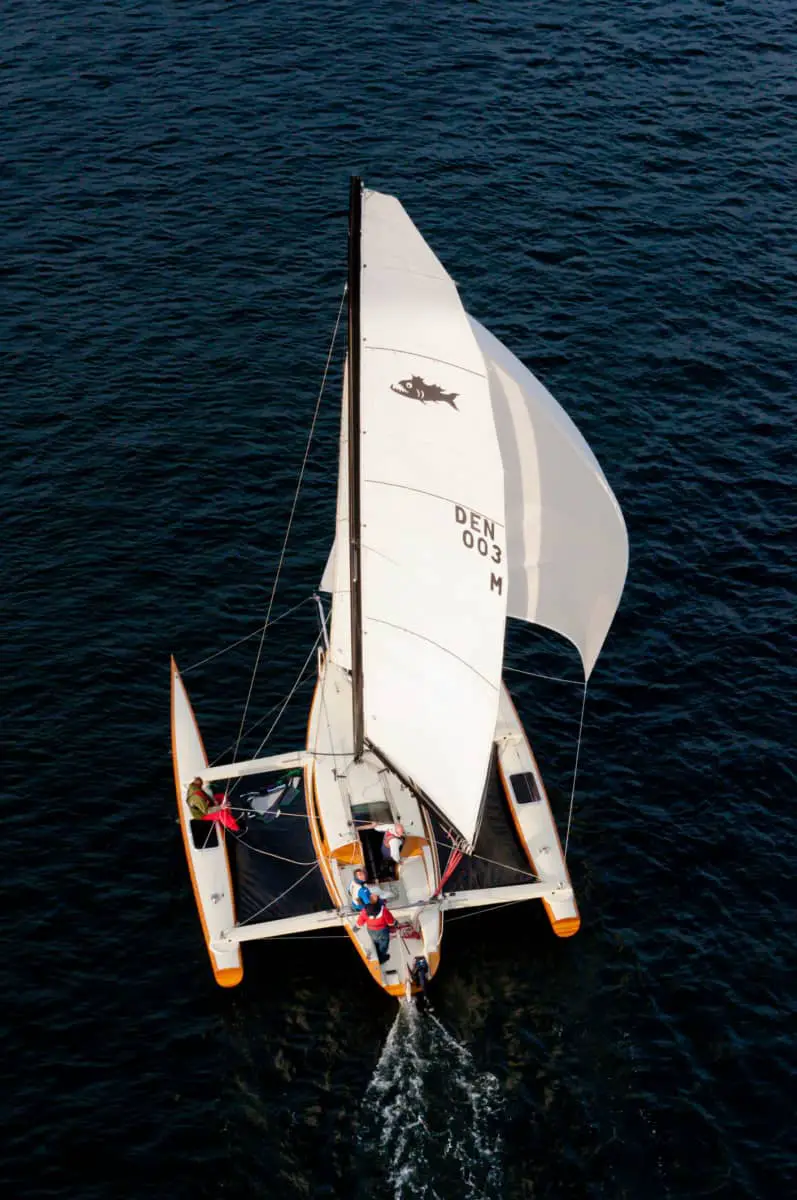As an Amazon Associate, we earn from qualifying purchases. We may also earn commissions if you purchase products from other retailers after clicking on a link from our site.
Most boat lovers know the differences between a catamaran and a monohull. But when it comes to differentiating between a catamaran and a trimaran, things can get tricky because it’s not always clear how much difference the extra hull of a trimaran makes in performance, safety, comfort, and handling. If you’re trying to choose between the two, this is a post you’ll want to read before making a decision.
Besides the number of hulls catamarans(two) and trimarans(three) differ in speed, safety, accommodation, helming, and anchoring. Generally, catamarans are more manageable in a marina and provide better accommodation and comfort. Trimarans, on the other hand, are faster and more fun to helm.
In this post, we’ll cover these differences in greater detail to make it easier for you to choose between a catamaran and a trimaran. First, let’s quickly review each multihull type.
The Lowdown on Catamarans
Informally dubbed a “cat,” a catamaran is a type of multi-hulled sailing craft with two equal-sized parallel hulls. Cats are typically geometry-stabilized, leveraging their wide beams for stability. That’s unlike monohull boats, which use ballasted keels for stability. Catamarans also have a smaller displacement, lower hull volume, and a much shallower draught (draft) than similarly sized monohulls.
The earliest forms of catamarans can be traced way back to the 17th century. They were primarily used for fishing by the Pavaras community in Tamil Nadu, who preferred them over other fishing vessels due to the extra balance and stability provided by the twin hulls. Later on, the British adopted the concept of twin-hulled boats and popularized it worldwide.
Modern catamarans are much more sophisticated than their ancestors. They’ve evolved in terms of the usage versatility, construction, and design, giving rise to two primary configurations:
The hulls in a catamaran with a SWATH configuration are typically submerged. That means they’re less affected by ocean waves, which is great for stability when sailing in rough waters. In the recent past, SWATH configurations have been used on research vessels and rescue ships.
Their wave-piercing counterparts, on the other hand, have low-buoyancy bows fitted on the twin hulls. The bows allow the hulls to puncture ocean waves instead of riding over them, making catamarans with such a design faster on rough waters than SWATH cats. In the recent past, wave-piercing cat designs have been used on passenger ferries, military vessels, and yachts.
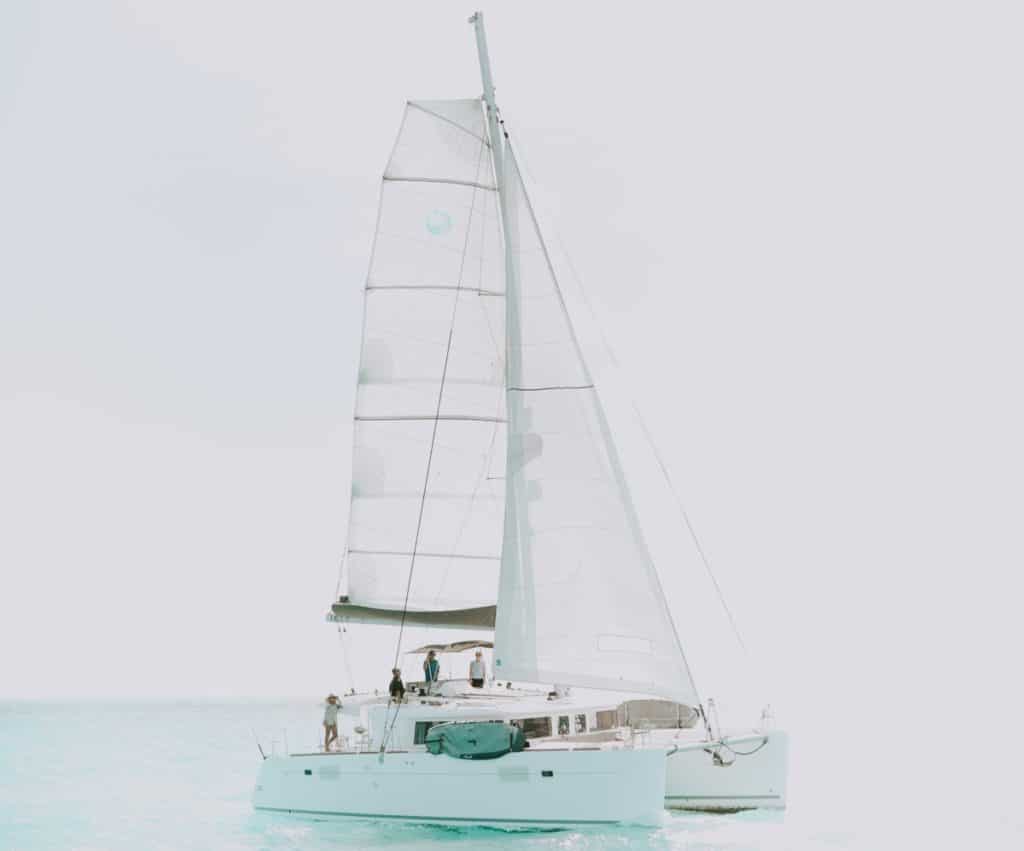
The Lowdown on Trimarans
Also known as a double-outrigger, a trimaran is a type of multihull boat with one main hull flanked by two smaller “floats” (technically known as outrigger hulls) connected to the larger hull by lateral beams. Such a design makes trimarans incredibly stable, meaning they’re hard to capsize even in the roughest of waters.
The earliest forms of trimarans can be traced to the Austronesian people and are still the most common hull design you’ll find on traditional fishing boats in Maritime Southeast Asia. The majority of today’s double outriggers are yachts meant for racing and recreation, but some warships and ferries have this design.
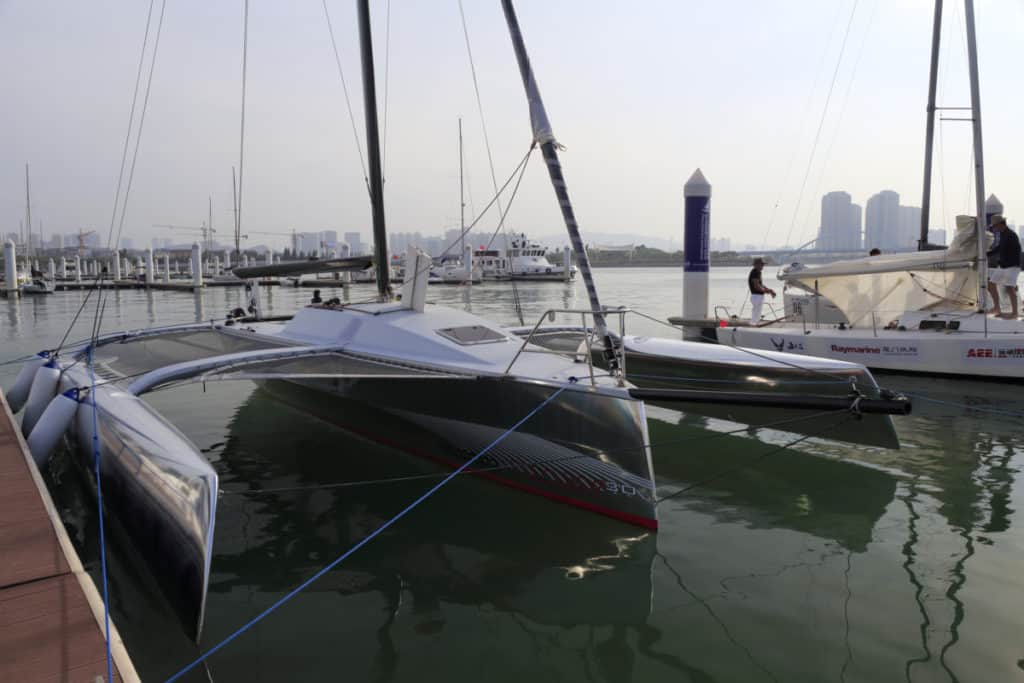
The Differences Between Catamarans and Trimarans
The most apparent physical distinction between a catamaran and a trimaran is that it has three hulls instead of two.
But other than that, are there other differences between the two vessel types you need to know? Do those differences make one type better than the other?
To find out, let’s compare the two types of multihulls based on the following merits:
Comfort and Accommodation
A Cat’s geometry is ideal for comfort and accommodation. The two load-bearing hulls provide additional habitable space, and you can always create a sizable nacelle between them. Connected to this central living space is a large cockpit, and there are cabins on either end of the hulls. This arrangement is perfect when you’re looking to relax a bit as the party rages on in the saloon because it gives you a bit of privacy.
And with flybridges virtually standard on modern catamarans, you have extra space for entertainment and lounging. The deck area is safe for kids, and the fact that catamarans don’t heel much means that you can do things like cooking at ease. Also worth mentioning is that cats can carry a decent load, meaning you can stock up on food and gear when going away for an extended period.
While trimarans do provide a decent degree of livability, they fall short of catamarans in two regards. First, they heel more than cats, making it difficult to do things like cooking on board. Second, they support much less load than catamarans. To put things into perspective, some 45 feet (14 meters). Cats can carry nearly three tons of payloads, whereas similarly sized trimarans can barely support half that load.
Overall, catamarans provide better, more comfortable accommodation than trimarans.
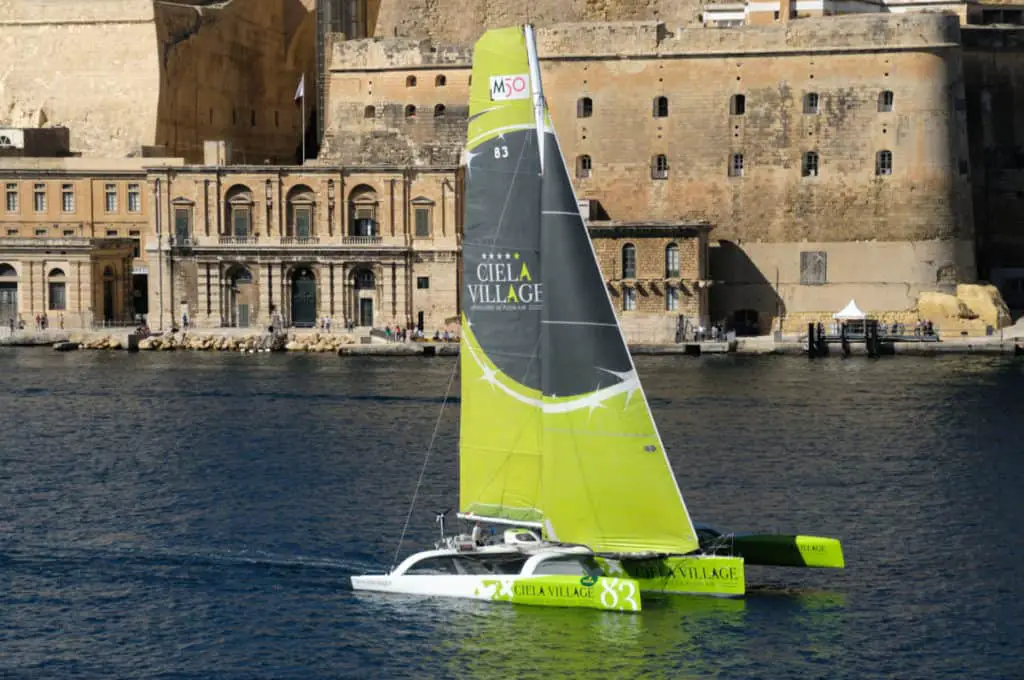
Safety
One of the main concerns when choosing any water vessel is how easy it’ll capsize in the event of a storm. If you’re looking to spend more than just a couple of hours on the water, you want to sail on something that won’t capsize/sink easily because sea conditions can sometimes fluctuate within a short period.
When it comes to safety, three hulls are better than two. Having one main hull and two overhangs on each side makes a trimaran more stable because of two reasons. First, the side overhangs widen the beam of the vessel, which minimizes the chances of the boat flipping over when hit by a large breaking wave from the side. Second, trimarans are typically designed with the weight centered on the main hull, further enhancing stability.
Multihull stability is a complex topic and should be understood in detail if you want to stay safe at sea!
On the rare occasion that a trimaran flips over, it’ll stay afloat. That means if the worst happens, a capsized trimaran will turn into a potential life-saving raft that’s easier to spot from a helicopter. That’s because almost all trimarans designed in the last decade or so come with closed-cell foam distributed throughout the various parts of the boat to provide reserve buoyancy.
Thanks to this kind of construction, you could cut most trimarans into pieces, and each would still stay afloat.
While catamarans are typically more stable than monohulls, they’re no match for a trimaran in this regard. Hypothetically speaking, it would be easier to tip over a catamaran than a trimaran if both boat types were subjected to equal magnitude storms. That, however, doesn’t mean that catamarans aren’t safe. They’re still harder to flip over than monohulls and will stay afloat when that happens because they come with the same closed-cell foam found in a trimaran.
While on the subject of safety, it’s worth mentioning that trimarans require less vigilance as far as reefing is concerned. Since catamarans heel less, most of the extra wind force translates to more “push” on the rig, increasing speed. But because the pressure exerted on the sail nearly quadruples when the wind speed doubles, you need to be extremely careful when timing your reef to keep a cat sailing flat.
The same goes for reefing a trimaran, except that the slight heel gives you more room for error in terms of the timing.
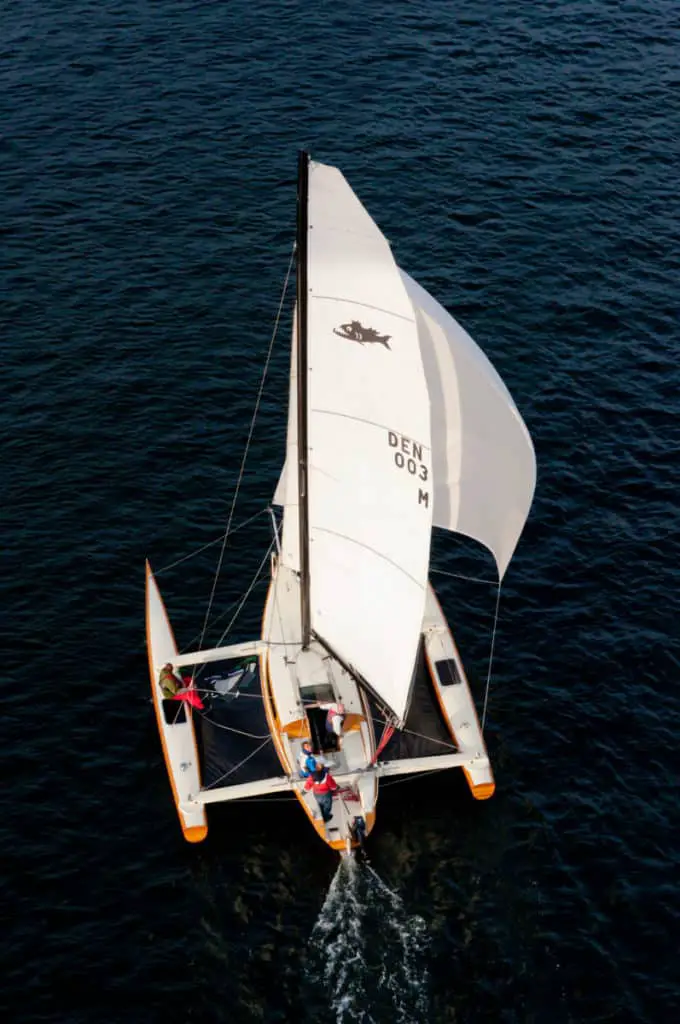
Helming
Most people who’ve ever steered both a trimaran and catamaran will agree that the former is more fun to sail. Most light trimarans, especially tiller-steered ones, have a terrific response to the helm. They have a slight heel that somewhat feels like a monohull, but the angle is a bit limited.
A catamaran is stable, but it doesn’t heel. While heeling may be frowned upon by people who prioritize comfort and accommodation in a boat, it’s one of the most exciting parts of sailing. With three hulls to ensure stability, trimarans combine the heel of a monohull with a catamaran’s stability to deliver the best sailing elements of monohulls and multihulls in a single package.
Considering that trimarans are more stable, you may be better off with one if you’re looking to have some fun as you perfect your helming skills.
Speed
Speed is another area where trimarans outperform their twin-hulled counterparts. Typically lighter than catamarans, trimarans need less sail distance to hit double-digit speed averages. A trimaran can maintain a formidable course up-wind when fitted with centerboards/daggerboards (as is often the case for modern models).
While a catamaran is still faster than a monohull of identical size, it falls short of the trimaran in terms of sheer speed. Understand that this doesn’t make catamarans slow boats; it’s just that tris are typically designed with more emphasis on performance.
Why are Trimarans Faster Than Catamarans?
Anchoring
Trimarans are easier to anchor than catamarans because they allow you to keep the ground tackle in and deploy it from the main hull.
However, catamarans are more maneuverable and manageable in a marina. They also handle docking lines more conveniently.
Catamarans vs. Trimaran: The Verdict
In summary, here’s what the differences between a cat and tri mean for anyone trying to choose between the two: A catamaran is a better choice if you’re looking to accommodate many people on board for something like a party because it’s more spacious and comfortable than a trimaran. On the other hand, a trimaran is an ideal choice for speed junkies and individuals looking to push their sailing skills to the next level on every stable platform.
Hopefully, that has cleared the air and made it easier for you to pick a more suitable option for your sailing needs.

